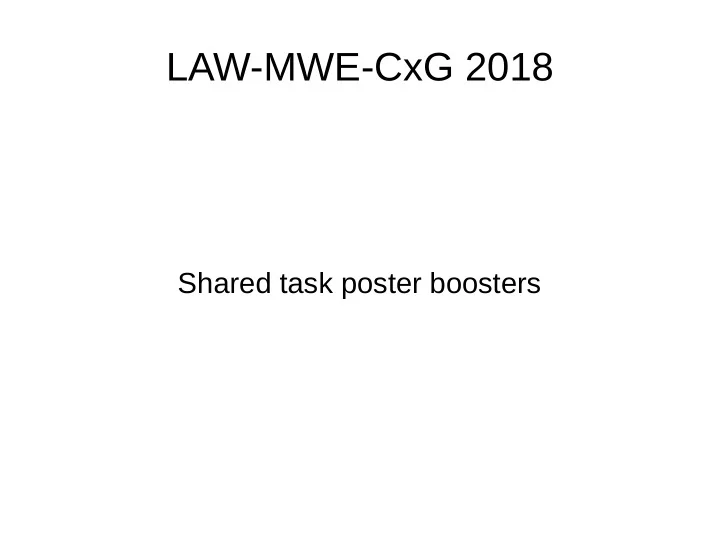

LAW-MWE-CxG 2018 Shared task poster boosters
1. DEEP-BGT AT PARSEME SHARED TASK 2018: BIDIRECTIONAL LSTM- CRF MODEL FOR VERBAL MULTIWORD EXPRESSION IDENTIFICATION, Gözde Berk, Berna Erden and Tunga Gungor 2. GBD-NER AT PARSEME SHARED TASK 2018: MULTI-WORD EXPRESSION DETECTION USING BIDIRECTIONAL LONG-SHORT-TERM MEMORY NETWORKS AND GRAPH-BASED DECODING, Tiberiu Boroș and Ruxandra Burtica 3. MUMPITZ AT PARSEME SHARED TASK 2018: A BIDIRECTIONAL LSTM FOR THE IDENTIFICATION OF VERBAL MULTIWORD EXPRESSIONS, Rafael Ehren, Timm Lichte and Younes Samih 4. CRF-SEQ and CRF-DEPTREE AT PARSEME SHARED TASK 2018:: DETECTING VERBAL MWEs USING SEQUENTIAL AND DEPENDENCY- BASED APPROACHES, Erwan Moreau, Ashjan Alsulaimani, Alfredo Maldonado and Carl Vogel 5. VARIDE AT PARSEME SHARED TASK 2018: ARE VARIANTS REALLY AS ALIKE AS TWO PEAS IN A POD?, Caroline Pasquer, Agata Savary, Carlos Ramisch and Jean-Yves Antoine 6. VEYN AT PARSEME SHARED TASK 2018: RECURRENT NEURAL NETWORKS FOR VMWE IDENTIFICATION, Nicolas Zampieri, Manon Scholivet, Carlos Ramisch and Benoit Favre
Deep-BGT at PARSEME Shared Task 2018: Bidirectional LSTM-CRF Model for Verbal Multiword Expression Identification Gözde Berk, Berna Erden and Tunga Güngör Department of Computer Engineering, Boğaziçi University, Istanbul, Turkey
First Language- Bidirectional independent LSTM-CRF Gappy Bidirectional system model in 1-level LSTM-CRF VMWE Sequence tagging identification model tagging approach 2nd in the open track
Multi-word Expression Detection using Bidirectional Long-Short-Term Memory Networks and graph-based decoding
Mumpitz at PARSEME Shared Task 2018: A Bidirectional LSTM for the Identification of Verbal Multiword Expressions Rafael Ehren, Timm Lichte, Younes Samih University of Düsseldorf, Germany August 25, 2018 SFB 991
A BRNN with LSTMs for VMWE identification The assumption : Bidirectional recurrent neural nets (BRNNs) are a good fit for this task, because they perform well on simi- lar sequence tagging tasks like POS tagging and named-entity recognition and a BRNN was employed in the last year’s edi- tion of the shared task. The system : Mumpitz consists of a BRNN with long short- term memory (LSTM) units and a heuristic that leverages the dependency information provided in the PARSEME corpus data to differentiate VMWEs in a sentence. The results : We submitted results for seven languages in the closed track (BG, DE, EL, ES, FR, PL, PT) and for one language in the open track (DE). For the open track we used pretrained instead of randomly initialized word embeddings to improve the performance of the system. Ehren, Lichte, Samih (HHU) 2
A BRNN with LSTMs for VMWE identification Come in and have some breakfast L LP D 0 LSTM LSTM LSTM LSTM LSTM LSTM LSTM LSTM LSTM LSTM LSTM LSTM 0 Out Out Out Out Out Out * * * VMWE * VMWE Figure 1: Unrolled BRNN for VMWE tagging. Ehren, Lichte, Samih (HHU) 3
CRF-Seq and CRF-DepTree at PARSEME Shared Task 2018: Detecting Verbal MWEs Using Sequential and Dependency-Based Approaches Erwan Moreau, Ashjan Alsulaimani, Alfredo Maldonado and Carl Vogel Adapt Centre & Trinity College Dublin
Dependency Tree Approach dependency tree (the basic one) (the fancy one) Sequential Approach expressions ▶ Based on data analysis ▶ Sequential CRF ▶ Target: discontinuous ▶ Lemma and POS tag only ▶ Brute-force feature selection ▶ Uses information from the ▶ Complex CRF dependencies ▶ Feature selection ▶ ... → 1 month work → 6 hours work (on the last day!) → Decent perf → Frustratingly high perf ▶ F-score 50.6% ▶ F-score 54.6%
VarIDE at PARSEME Shared Task 2018: Are variants really as alike as two peas in a pod ? Caroline Pasquer, Carlos Ramisch, Agata Savary and Jean-Yves Antoine Problem Method Identify previously seen VMWEs and Extract (relevant) co-occurrences of their variants . Omit literal readings the lemmas in seen VMWEs. and incidental co-occurrences . Classify the candidates based on their train : variability profile. We build a bridge between countries. Naive Bayes classifier test : absolute features (POS, morphology, The bridges he built between cultures. dependencies) relative features (comparison of a Tower Bridge was built in 1886. candidates with seens VMWEs) The house was built near the bridge . Results 5th (out of 13) in the closed track 2nd for discontinuous VMWEs, 1 2 2 6th for variant-of-train VMWEs
What does this have to do with? Veyn: recurrent neural networks for VMWE identification Nicolas Zampieri, Carlos Ramisch, Manon Scholivet, Benoit Favre • Sequence tagger based on recurrent neural networks • Variant of begin-inside-outside + VMWE category O B-LVC G G I-LVC Label ~ ~ ~ ~ ~ Softmax 2 recurrents layers biGRU Concatenation POS PROPN VERB DET ADJ NOUN Lemma Jean prendre de long douche Jean prend de longues douches Sentence
Why should you check out our poster? • Know the gory details about the system implementation • Study of alternative encoding schemes on dev corpus • Discuss strengths and weaknesses of the system • 19 languages , ranked 9 th (MWE-based) and 8 th (Tok-based) • Improvements and extensions since submission The icing on the cake Veyn is freely available: https://github.com/zamp13/Veyn
Recommend
More recommend